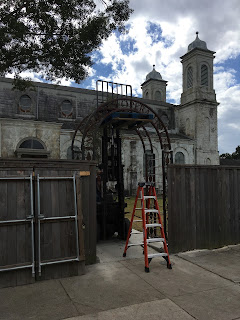by Sharon O'Brien
It’s beginning
to feel a lot like Christmas. From the elegant Arbor House wreaths on the St.
Ferdinand Street doors to OperaCréole’s
authentic Creole Christmas tree on stage, the joyful sounds of the season are
peeling out from Marigny Opera House.
Two unique holiday programs by
artists familiar to MOH supporters will bring down the curtain on 2016. “Both OperaCréole and BREVE share an
uncommon dedication to the study and performance of works that are overlooked
and underperformed,” says Founder and Executive Director
Dave Hurlbert. Although much of his own focus is on new work, he sees
tremendous value in bringing these neglected musical gems to new generations of
audiences.
First up this weekend is OperaCréole’s sumptuous tribute to tribute to the Advent and
Christmas traditions of Creoles from years past in “A Creole Christmas.”
“We’re dedicated to researching and
performing lost or rarely performed music, and sharing with the community the
contributions of our people to this musical art form, not only in New Orleans,
but around the world,” says Giovanna Joseph, Founder and Executive Director of
the internationally recognized opera company.
“Opera and classical music in New
Orleans and around the world have always included the contributions of persons
of color, “Joseph continues. No surprise
then that OperaCréole’s next MOH production
is Lucien Lambert’s rarely performed La Flamenca (1889). Lambert, son of Charles Lucien Lambert, was a New Orleans born
free Creole composer of color who found success in France. The four act opera
is scheduled for May 19-21 2017.
At a time of year when we both look
forward to the future and recollect the traditions of the past, BREVE (The
Baton Rouge Early Vocal Ensemble) returns to MOH to present “Christmas in the
Marigny,” an a capella program of traditional carols and music on Saturday,
December 17 at 7 p.m.
Founded in 2010, The Baton Rouge
Early Vocal Ensemble is one of the few early music ensembles in the state of
Louisiana. They are dedicated to the study and performance of Renaissance and
Baroque music that is lesser-known and under-appreciated. Special emphasis is
given to musical works that have no discography.
Tickets for both
productions are available online
Put Us on Your Christmas Tree
The 2016 Mignon Faget
Adornament -- a handcrafted 24K gold-plated bronze replica of the iconic
Marigny Opera House – is a collectible that benefits the Marigny Opera House
Foundation, a non-profit organization whose mission is to support the work of
local performing artists.
Only 35 of these bespoke creations
remain.
Shop now on our website (http://bit.ly/2gnu08x) through December 16. Your $40 gift means that
you’ll receive the adornament via USPS within five business days.
And All That Jazz
If you missed our sold
out “Giselle Deslondes” in November, better plan now for Marigny Opera Ballet’s
“The Art of Jazz,” three premieres by Diogo de Lima, Nikki Hefko and Barbara
Hayley, with music composed and performed by jazz artists Helen Gillet, Larry
Sieberth and Nutria (Byron Asher, Trey Boudreax and Shawn Myers).
Tickets $35/$25 Students
and Seniors, available online or at the door. Performances Thursday Feb. 9th,
Friday Feb. 10th, and Sunday Feb. 12th (No Saturday performance).
Time to Reflect, Time to Remember
The awe and wonder of
Christmas pageants past at Holy Trinity Church are part of a past that’s
cherished and embraced. Now, as we end our fifth year as a Church of the Arts,
we look forward to many more tomorrows of dance and music and theatre.
So many people and
organizations got us to today. Not to mention performers, dancers, composers,
actors, directors, singers, musicians, costumers, staff and volunteers. Board
members. Audiences. Neighbors. Sponsors. Subscribers. Holy Trinity Church and
School supporters. We love you all and wish you the happiest of holidays.









